Micro Auray Punt
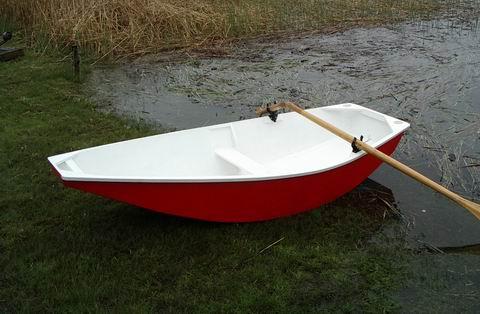
In 1912 Claud Worth took measurements from a punt he saw
local fishermen using on the Atlantic coast in Auray, France.
Philip Bolger later adapted these mesurements for plywood in
his book "Boats with an Open Mind",
creating a 9'9" x 4'2" plywood punt. "Small Boat Journal"
published a 10' version of the "Auray punt" in number 25,
July 1982.
This is a one sheet version of the same punt, adjusted to
be made of just one sheet of plywood.
As it happens, the boat
scales down very nicely. The overall shape is conserved
beautifully. Both length and beam are 3/4 of the original,
so the L/B ratio is the same, about 2.2. The shape looked
from above is the same. The height is 4/5 of the original,
so the "Micro" is proportionally slightly higher than the
original "Auray".
The total volume is 0.45 times that of the original, so if the
original is a boat for 2 to 3 people, this is a one person
boat.
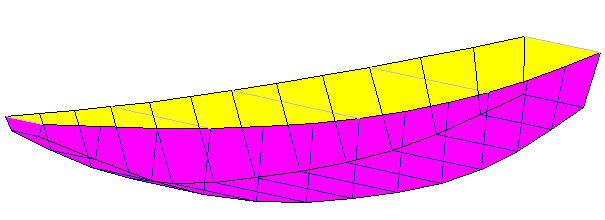
The "Micro Auray" measures 7'2" x 3'3" and can be built using the
split side technique established in the
"Simbo" section. She displaces
about 780 lbs just before flooding. At 250 lbs, one
person load, her freeboard is about 7".
See also the "Mini Auray",
a one and a half sheet Auray punt.
Here is the "Micro Auray" .hul file
for those interested.

To construct the punt cut the plywood like this. The bow transom
is not shown, it is best to cut it out of a piece of plank. So
strictly speaking, this is not a real one sheeter ;-)
The red lines show where the side strips will be cut in two
eventually.
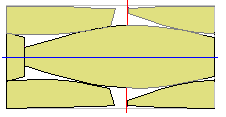
First draw a line lengthwise in the middle of the plywood sheet.
From this centerline, measure and mark the bottom
on one end of the sheet according to these measurements. Loft
the side curve on one side only. Just mark the measurements with
small dots on the other
side.
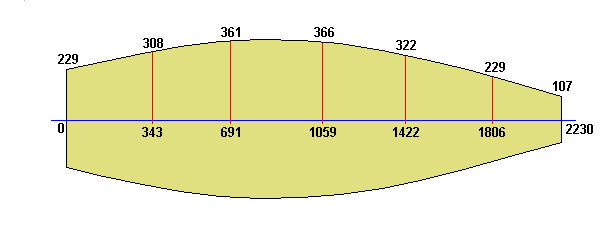
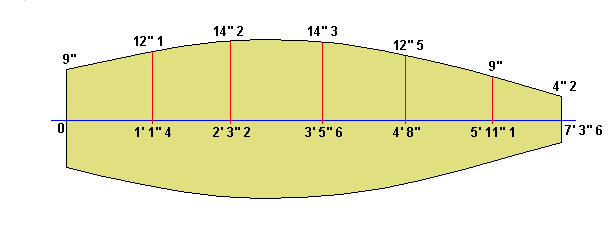
Then measure and mark the transom on the other end of the sheet.
The transom and bottom meet, there'll be no left over plywood
between them.
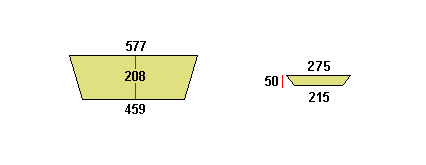
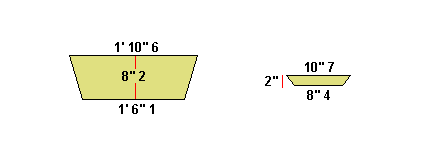
Saw along the lofted side of the bottom.
Then flip the side strip You just created over, onto the
other side of the sheet, and draw the other edge of the bottom
along the sawn edge of the side. Check that the drawn curve matches
the measured points.
Cut the other edge of the bottom and transom. You now have
four pieces of plywood: the bottom, transom and two side strips
of rather nonspecific shape.
Cut both side strips in two, 1400 mm (55") from the end where
the transom came from. Swap the pieces, and connect the wider ends
of the strips using butt joints.
When the glue has hardened, measure and loft the side onto one of
the strips. Then saw out the sides from both strips in one go,
strips on top of each other.
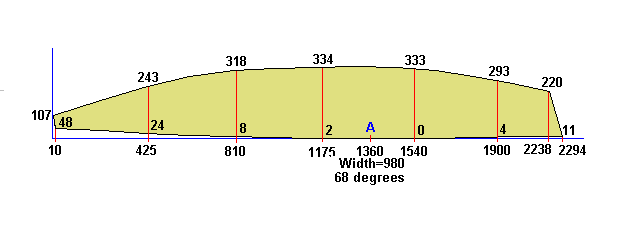

Mark the point "A" to both sides.
The sculling seat rear edge (closer to stern) will
be directly beneath point "A" in the finished boat.
The distance between sides will be set to 980 mm between
points "A", with a length of board, with ends cut to 68
degrees angle.
 |
A plywood sheet cut into pieces according to the scheme shown above.
I use 4 mm (5/32") birch plywood to make the boat as light as possible.
Using thin (=flimsy) plywood like this makes building slightly more
difficult than using 6.5 mm (1/4") ply. The thicker ply would
make the boat stronger, too.
Both thicknesses are possible, it's just the choice between
strength and weight.
|
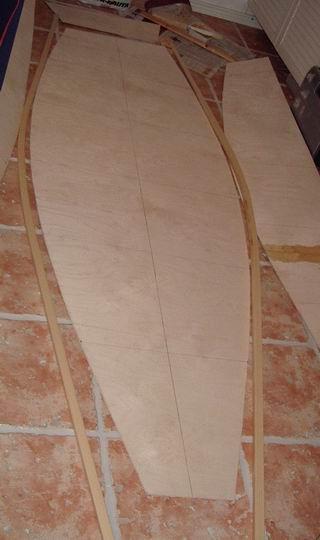 |
Sides butted with glass tape on either side of the ply and gunwale
battens bent with the help of a heat blower gun.
|
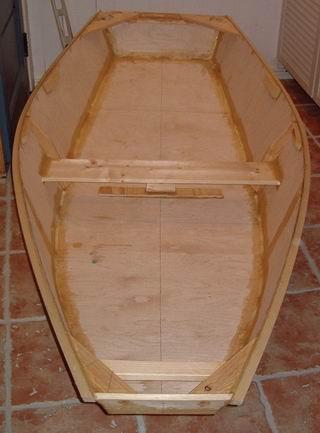 |
Wood and epoxy work finished, but not sanded yet.
Up to here I used much the same techniques as with the
"Simbo". Small wooden
blocks and screws through the plywood for stitching the
pieces together.
- On the first evening stitch the plywood pieces together
with 2" x 2" x 2" wood blocks 1' apart and small screws,
apply an epoxy putty bead between the blocks, glue the quarter knees,
seat and transom stiffeners.
- On the second evening remove the stitch screws and blocks, complete
the bead, apply glass tape on the inside and glue on the gunwales.
- On the third evening turn the boat over, round the chines,
apply epoxy putty and glass tape on the outside of the chines.
|
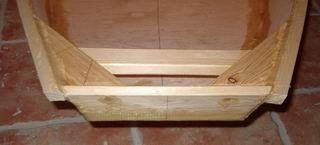 |
Bow details.
The bow transom and quarter knees are of 70 x 12 mm
(3" x 1/2") pine.
The cross member of 45 x 21 mm (1 3/8" x 7/8")
pine is not a necessary item, it's a handle.
It can be left out.
In my opinion boats always have too few handles. The
cross member provides an excellent handle to carry
or drag the boat. In addition, it increases the
torsional stiffness of the "snout".
|
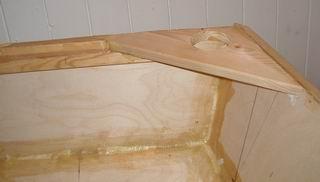 |
Stern details.
Quarter knees in the stern are of of
145 x 18 mm (6" x 3/4") spruce. The 64 mm
(2 1/2") holes act as handles, can be used as
fastening points for ropes, and they look nice,
imho.
The stern transom cross members (double)
are of 21 x 21 mm (7/8" x 7/8") pine. These
stiffeners are needed, since the thin plywood
transom by itself could not take the bending
forces from the gunwales.
The gunwales are of the same 21 x 21 mm (7/8" x 7/8") pine
batten.
|
You may ask "why are some pieces of pine, some of spruce?"
Spruce is much lighter than pine, but usually has lots
of small knots.
It is difficult to find thin battens of spruce without knots.
When being bent, a thin batten usually breaks at a knot.
Also, not all lumberyards store all sizes in all
wood species. My local lumberyard mainly sells spruce and
pine. There are other woods in the world, of course...
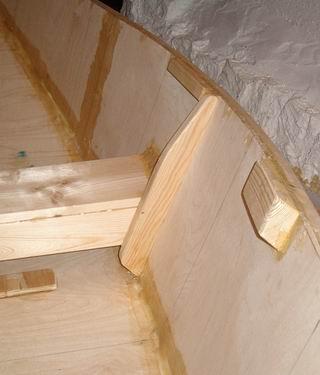 |
Seat details.
Seat side frames are of 45 x 21 mm (1 3/8" x 7/8") pine,
hewn to a nice shape, glued to the sides.
Seat cross member under the seat, glued and screwn to the side
frames, is of 70 x 12 mm (3" x 1/2") pine.
The seat itself is of
145 x 18 mm (6" x 3/4") spruce, glued to the cross member
and sides.
The 12 mm (1/2") plywood "foot" under the seat does
not support the seat but the flimsy bottom. If 6.5 mm (1/4")
plywood was used, this foot would not be necessary.
The oarlocks will be situated 30 cm (10") astern from the
seat rear edge.
|
 |
The 150 mm (6") lengths of 21 x 21 mm (7/8" x 7/8") pine above
the seat on the inside of the gunwale are handles (again :-).
They are at the lengthwise center of gravity of the boat,
so the boat can be carried like a suitcase.
The true weight of the boat is 12 kg (26 lbs) so carrying
is a real option. But again, these handles can be left out
if You think You'll never carry the boat. Don't fool
Yourself ;-)
|
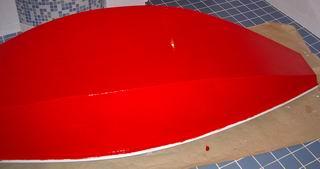 |
Bottom painted bright red. This is always the difficult part:
what colour to paint Your boat?
|
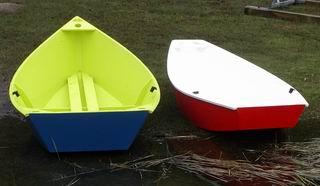 |
Finally by the sea. Here You can see the difference between a one
sheet boat and a one and a half sheet boat. Quite a lot!
The blue boat is my
sharp bow dinghy.
|
 |
But no pictures of the maiden voyage (which I did, by the way) yet.
The weather was so miserable (cold and rainy), that I couldn't get
anyone with me to take pictures.
Anyway, the first impression on the sea was, that she's a really
touching little boat. Ligth to scull, tracks well without a skeg
and feels stable for her size.
|
 |
Another day, the sun is shining.
The oars I'm using on the pictures are 6 ft / 180 cm.
That's about optimum for Micro Auray.
6 ft oars are very short for oars, but Micro Auray is
narrow for a boat, so short oars have to be used.
Up to 7 ft / 210 cm would be ok.
|
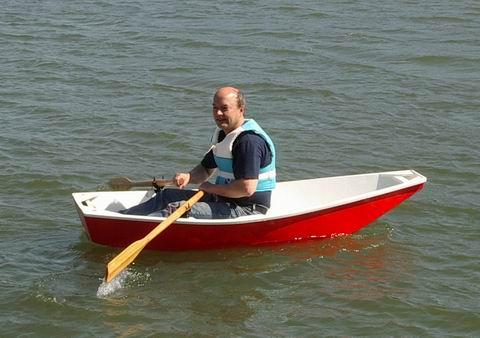 |
You might just be able to see, that the lower edge of the
transom is just clear of water, so the balance is just like
intended, the seat position is correct.
|
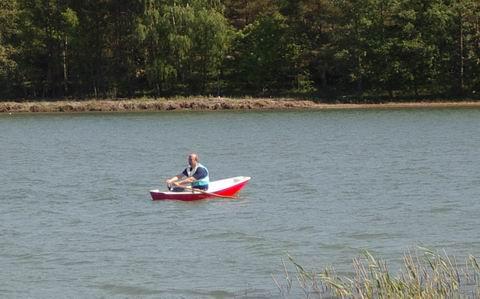 |
So long, I'm on my way!
|
Top of the page.
Back to main page.






















